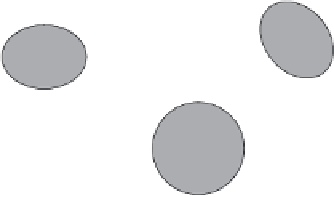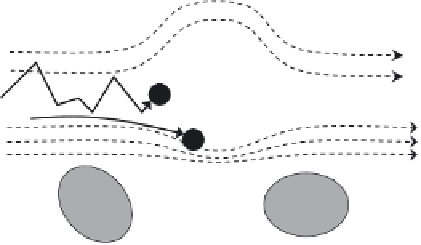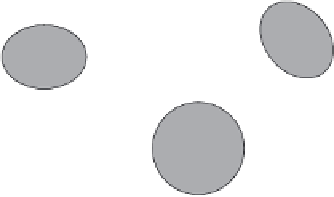Environmental Engineering Reference
In-Depth Information
viscosity). Colloid transport or deposition in porous media can be thought of as
occurring in two steps (McDowell-Boyer
et al.
, 1986): (i) transport to the vicinity
of the soil or sediment grains themselves (collector) by surface fi ltration, straining
fi ltration, diffusion or physical-chemical mechanisms leading to collision; and (ii)
the attachment to the collector via electrostatic interactions between the colloid
and the soil. Attachment and aggregation were discussed in Section 4.5.
Large particles can be removed by surface fi ltration (a fi lter cake or a surface
mat formation) above the media. In saturated media, colloids can be removed
mechanically by sieving or straining in smaller pore spaces if colloids or aggregate
dimensions exceed the pore space. Straining fi ltration may occur even for particles
much smaller than the average grain size of narrowly distributed grains. Under
strongly repulsive conditions with no physico-chemical fi ltration, Xu
et al.
(2006)
determined that for straining fi ltration to become negligible, the ratio of grain size
to colloid size must be larger than 125.
For smaller colloids, physical-chemical mechanisms can be further divided into
three deposition processes: diffusion, interception, and sedimentation (Figure 4.16).
Diffusion limited deposition is driven by Brownian motion of the colloids, hence,
it strongly depends on their size. Small colloids (
100 nm) in particular are depos-
ited by collision to the porous media due to diffusion. Interception describes the
collision between colloid and the collector if the fl ow path of a colloid with a
defi ned diameter intersects the stationary collector. This process is especially
important for colloids/aggregates larger 1
<
m. Sedimentation of colloids is due to
a difference in colloid to fl uid density (mainly for larger (
µ
200 nm) or dense col-
loids) (McDowell - Boyer
et al.
, 1986). These three processes relate to the three main
aggregation processes, perikinetic (diffusion), orthokinetic (shear) and differential
settling. In addition, for unsaturated systems colloid retention at the stationary,
>
collector (grains)
C
hydrodynamic flow vectors
particle trajectories
A
particle filtration by diffusion
A
B
B
particle filtration by interception
particle filtration by settling
C
Figure 4.16
Particle fi ltration by (A) diffusion, (B) interception and (C) sedimentation.
(Adapted from K.M. Yao (1968), Infl uence of suspended particle size on the transport aspect
of water fi ltration, University of North Carolina, Chapel Hill, Dissertation.)










Search WWH ::

Custom Search